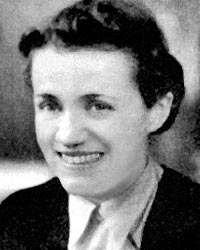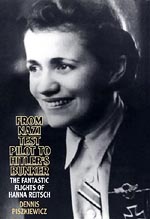
Hanna Reitsch (1912-1979)
In the 1932, medical student Hanna Reitsch began soaring and went on to become one of the first few people to cross the alps in a glider. As the world's first female test pilot and helicopter pilot, Hanna flew everyting the Third Reich had: from the first helicopter (the Focke-Achgelis) to the prototype of a piloted V-1. She went on to set more than 40 altitude and endurance records in motorless and powered aircraft in her lifetime.
One of her first feats was to fly the world's first practical helicopter inside of an exhibition hall. ...more
Hanna Reitsch : Nazi Germany's leading woman pilot Nazi Germany's leading woman stunt pilot and an enthusiastic admirer of Hitler who begged to be allowed to die with him in the Fuhrerbunker at the end of World War II, Hanna Reitsch was born in Hirschberg, Silesia, on 29 March 1912, the daughter of an ophthalmologist.
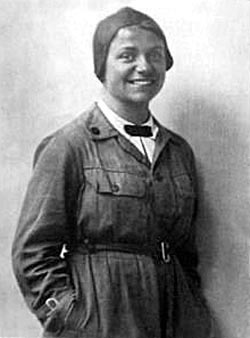 A young Hanna Reitsch
The diminutive, slightly built blonde, who was to become a symbol of virile heroism in the 1930s, originally aimed to be a flying missionary doctor in Africa, but turned instead to piloting gliders and powered aircraft with daring and unusual skill.
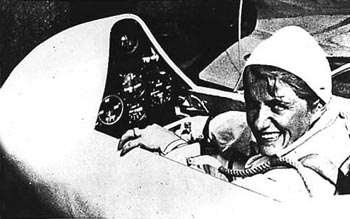 Hanna Reitsch, Apr., 1927
From 1931, when she set the women's world record for non - stop gliding (five and a half hours), extended to eleven and a half in 1933, to her world record in non - stop distance flight for gliders (305 kms) in 1936, and her woman's gliding world record for point - to - point flight in 1939, Hanna Reitsch's feats were unrivaled.
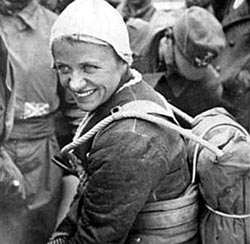 Hanna Reitsch
In 1934 she set the world's altitude record for women (2,800 m.), three years later she made the first crossing of the Alps in a glider, and in 1938 the first indoor helicopter flight in the Deutschlandhalle, Berlin. ...more
Hannah Reitsch Hanna Reitsch was born in Germany in 1912. She wanted to be a flying missionary doctor but, after the Versailles Treaty had clipped Germany's wings, she became an excellent glider pilot. She set records, she worked as a movie stand-in flyer, and she went on an expedition to study weather in South America. Hitler made her an honorary flight captain, the first woman to receive that award.
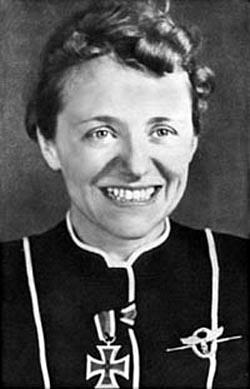 Hanna Reitsch wearing her Iron Cross and Luftwaffe Diamond Clasp http://www.wehrmacht-awards.com
In 1937, the re-formed Luftwaffe hired her as a civilian test pilot. She accepted with near reverence, calling German warplanes, "Guardians of the portals of peace." Historian Judy Lomax tells how Hanna Reitsch's values were instilled by a mother who wrote her daily, warning against the sin of pride and praying for her safety. ...more
Hannah Reitsch A great deal has been written about German aviatrix Hanna Reitsch over the years, much is made of her various exploits, but not everything she did warrants the fame that seems to have endured since the birth of Nazi Germany. There is no doubt that she was an excellent sailplane pilot and a very courageous woman, but some of her escapades were down-right foolhardy.
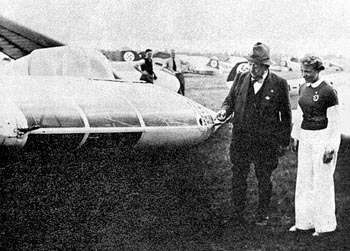 Hanna Reitsch about to test fly a Horten III Flying Wing Glider
In Nazi Germany of 1937 Hanna Reitsch was a role-model, her earlier fame had by then spread beyond national boundaries, and Ernst Udet appointed her as a test pilot to the Luftwaffe test center at Rechlin. This was not an officially published appointment, but a private gesture from Udet. It meant that she could fly only under the direction of Karl Franke, the chief test pilot at Rechlin, largely because her background experience did not justify her appointment. ...more
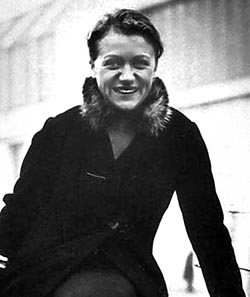 Hannah Reitsch
http://library.thinkquest.org In 1932, medical student Hanna Reitsch began soaring and went on to become one of the first people to cross the Alps in a glider. After graduating to powered aircraft, her daring and skill landed her in the forefront of Germany's aviation efforts. Even before the second World War, Hanna was recognized as Germany's leading aviatrix for her work flying experimental aircraft. One of her first feats was to fly the world's first practical helicopter inside of an exhibition hall. Always the professional flier, she was quickly recruited as a test pilot. The world's first female test pilot became known for her courage as she took on many unbelievably dangerous jobs, including testing a V-1 flying bomb equipped with a cockpit. ...more
Focke-Achgelis FW-61Focke-Achgelis FW-61http://www.flying-bike.fsnet.co.uk In 1937, Professor Heinrich Focke and another German named Achgelis joined forces to conduct helicopter research. The result was the production of the FW-61, based on the fuselage of a small biplane trainer with two outriggers supporting the contra-rotating rotors. The cut-down propellor mounted on the front of the radial engine was used only for cooling.
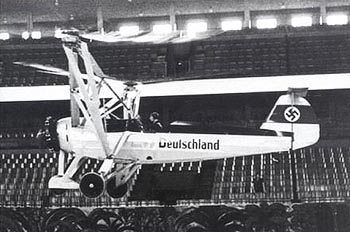 Hanna Reitsch, FW-61, Deutschlandhalle, Berlin, February 1938
The FW-61 rose to fame when it was demonstrated by Flugkapitan Hanna Reitsch inside the Deutschlandhalle stadium in Berlin. Hanna said that the machine was very easy to control, and claimed that she had only 3 hours experience on the machine before she made the first demonstration flight in the stadium. The FW-61 made its first autorotative (descent without power) landing in 1937.
Focke-Achgelis FW-61 High on the short list of helicopter pioneers must come the name of Doktor Heinrich Karl Johann Focke, whose Fw 61 made its first free flight, lasting 28 seconds, on 26 June 1936. This was, coincidentally, exactly one year after the less-publicised flight of the Breguet-Dorand machine, which can thus claim to have been the first really practical helicopter to have flown in Europe. But the Fw 61, once it had begun to fly, rapidly proved itself a much superior machine to the Breguet, not only as regards performance but as a practical basic design capable of much further development.
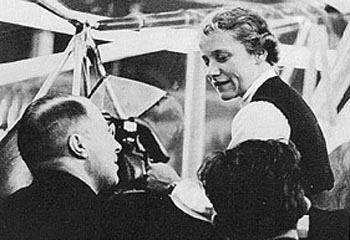 Hanna Reitsch, FW-61, Deutschlandhalle, Berlin, February 1938
"Professor Focke and his technicians standing below grew ever smaller as I continued to rise straight up, 50 metres, 75 metres, 100 metres. Then I gently began to throttle back and the speed of ascent dwindled till I was hovering motionless in midair. This was intoxicating! I thought of the lark, so light and small of wing, hovering over the summer fields. Now man had wrested from him his lovely secret"The Focke-Achgelis GmbH was an offshoot of the Focke-Wulf Flugzeugbau, established after Focke had been dismissed from the latter company by the Nazis as a political embarrassment. Focke's first experience of rotorcraft construction and operation was gained from building the Cierva C.19 and C.30 autogiros under licence, and then in 1934 he built and flew successfully a scale model helicopter that rose to a height of some 18m. There followed a period of research into, and testing of, rotor and transmission systems before, in 1936, the Fw 61 prototype made its appearance. ...more
Focke-Achgelis FW-61 Using as a starting point the experience gained from the Cierva Autogyro, and test models, Professor Focke now had enough faith in the concept of a true helicopter to proceed on to the construction of a full scale prototype, the FW-61. The fabric covered fuselage was of welded steel tube construction with conventional looking vertical tail and rudder.
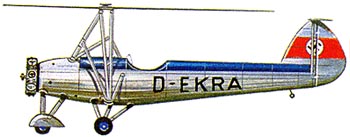 FW-61, c.1938
The horizontal tail was mounted on top of the vertical tail in a T like configuration. Today T-tails are common, but in the '30s this was a very unusual empennage arrangement. The horizontal segment had no elevator, but was adjustable in incidence by use of a trim wheel. ...more
Focke-Achgelis FW-61 Most people equate the development of the true helicopter as an American achievement, not realizing that the first rotary winged aircraft were developed in Europe, and that the process was long and tedious. Although there were Americans who experimented with rotary winged aircraft, the first successful types were developed by Cierva in Spain. In 1935, Focke designed and built a prototype of an autogyro which competed in the Luftwaffe contest to develop a utility and liaison aircraft. The winner was the Fieseler Fi-156 Storch, and only one FW-186, which was essentially a FW-56 Stosser advanced trainer fuselage with a single rotor assembly and a modified tail and landing gear. This provides the basis for another kit conversion, but not here.
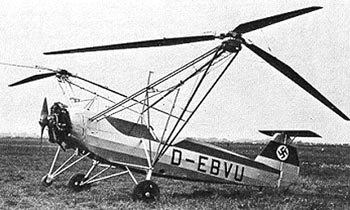 FW-61, c.1938
After the concept was established, Focke test flew a scale model of the design, and in 1934, this model achieved an altitude of 59 feet, which was equal to the altitude record for previous manned unsuccessful experimental helicopters. ...more THE KIT The origin of this project began when, many years ago, I obtained a Pegasus 1/72 scale Focke Wulf FW-44 Stieglitz training biplane. It was a little crude, even by the standards of the day, so I held on to the kit, hoping that something better would come along. When Huma released their FW-44 kit a few years ago, my problem was what to do with the old Pegasus kit. It did have some good points, but it really was fairly crude by modern standards, although the fuselage offered some promise. Then I got the idea of converting it to the FW-61 helicopter prototype, since the FW-61 was, in essence, a modified FW-44. The basic problem was research, since there was little information available on the FW-61.
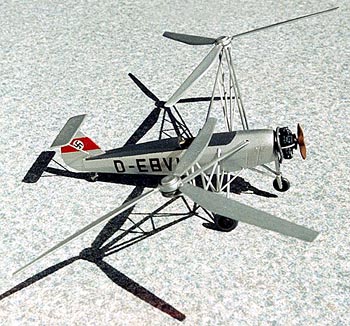 FW-61, c.1938
Fortunately, the internet came through, and I was able to find a pretty good selection of photos, data, and even a small three view of the helicopter described as being a "factory drawing". It wasn't all that helpful, as it seems that the FW-61 went through several configurations, with the rotor assembly remaining constant while the braces and strut assemblies changed from time to time. The only solution was to pick a photo of the aircraft taken at a particular time and use that as a guide. Two good sources for information, besides the photos I turned up on the internet, were Heinz Nowarra's German Helicopters, 1928-1945, a paperback published by Shiffer Military History, West Chester, PA, (ISBN 0-88740-289-5) published in 1990, and an article in Wings (date unknown) by Mal Holcombe entitled "Vertical Lift: A Little Known Look At German Helicopter Development Through the End of World War II, Which Preceded Our Own By Nearly Two Decades". I suspect that the issue was published before 1990, but the copy I have has no documentation. Both sources have a lot of information, and the Nowarra book has a number of three views, including that of one configuration of the FW-61, purporting to be of "factory" origin.
The Whirly Girls Their eggbeaters aren't in the kitchen." That statement encompasses the philosophy of the Whirly Girls, the premiere organization of international women helicopter pilots. Founded on April 28, 1955, it has grown into a major organization. At the outset, they were an unofficial group with no officers, no dues and no record of meetings. Six of the thirteen women helicopter pilots known in 1955 met on the mezzanine of the Mayflower Hotel in Washington, D.C. and decided to form a group to help other women who also desired to be helicopter pilots. The group was international in scope with three Americans, two French and one German. Today, there are over 1,000 Whirly Girls representing about 30 countries. The membership roster includes physicians, engineers, reporters, homemakers, airline pilots, and military pilots, all united by their single love of helicopter flying. ...more
GlidersThe Reiher Glidershttp://www.segelflug.de Hans Jacobs designed the Reiher for the international contest 1937 on the Wasserkuppe. It was layed out for highest performance and for easy handling at the contest. Its elegant shape shows the fine aerodynamics. The wing of the Reiher was designed to give the machine the highest performance of any contest machine of that time. With a proven L/D of 33:1, it is no surprise that it won the 1938 and 1939 contests.
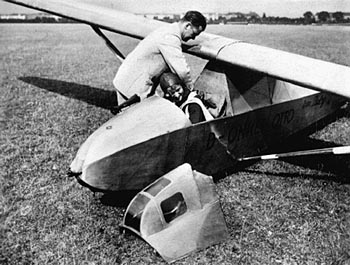 Wolf Hirth and Hanna Reitsch, c. 1930
The gullwing had a span of 19m. The wing chord was 140 cm, but a considerable proportion of this was a camber changing flap. Plywood covering of varying thickness from the wing root outwards was taken back to the rear spar. Wing ribs, close together, supported it to make the wing skin contribute more than usual to the wing's rigidity.
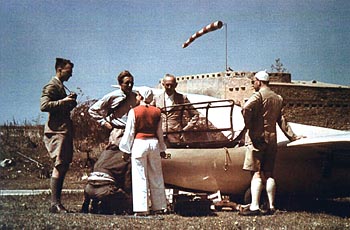 Rare colour photo of Hanna Reitch, Libya, 1939 (tbc) download a 750pixel image
In February 1939 an expedition to Libya under the leadership of Prof. Walter Georgii took place. Hanna Reitsch participated with a Reiher. Six Reihers where announced for the Rh^n contest in 1939, five appeared in the final results. Reihers came 1st, 9th, 12th, 16th and 19th. Erwin Kraft flew the winning Reiher, Spooote came 9th although his Reiher was damaged during transportation. Heinz Huth, who later became world champion in standard class twice, came 12th. Nobody knows what happened with the Reihers after the war and later. Perhaps one of them came to England after the war, but the traces there are lost.
Fieseler Fi 103A Pilot For The German V-1 Buzz BombIt is lesser known that the Germans designed a manned version of the V-1 called the V-1e. The V-1e was not intended to be recovered. It would have been launched, then guided to its target by a pilot on a suicide mission. Similar to the Japanese kamikaze concept, the V-1e group was code-named Project Reichenberg.
 Fieseler Fi 103, FZG 76 and its later manned version the Fi 103R
She believed the deployment of the V-1e as introduced would result in significant pilot losses, even if the pilot had agreed to perform a suicide mission. The Germans could not sustain design changes late in the war, so the V-1e was never deployed in combat.
The Fieseler Fi 103R The Fieseler Fi 103R manned missile was one of the many desperate projects conceived as the German situation became more hopeless. Basically the Fi 103R was a piloted version of the V-1 flying bomb, powered by the same Argus pulsejet engine. By mid-1944, preparations had been made for mass production, in time for the operation to attack the Allied forces amassed in southern England. The Fi 103R was to be carried by a parent aircraft and released near the target. Then the pilot would take over and direct the bomb into a dive towards the target. The pilot was to detach the canopy and bale out just before impact. The canopy, however, would almost certainly block the pulsejet inlet and reduce the chance of pilot survival to almost zero. Nevertheless, the Germans went to great lengths to distinguish their Selbstopfermo/oonner (self-sacrifice men) from the Japanese Kamikaze pilots, whose cockpits were sealed close before take-off. The Fi 103R's operation was codenamed Reichenberg and a total of about 175 manned Fi 103Rs (R for Reichenberg) were made. The R-I, R-II and R-III were used for test and training, and R-IV was to be the production model. Two Rechlin pilots crashed while test-flying the Fi 103R, and afterwards trial flights were transferred to DFR test pilots Hanna Reitsch and Heinz Kensche. Flying the Fi 103R was quite simple, since the Fi 103R's unmanned version could fly without direct control. Landing, on the other hand, was very difficult dur to the primitive control system, absence of landing gear and high landing speed. This should not have mattered much because the Fi 103R was not designed to return anyway! The project never took off, due to the Germany high command's apathy, even though some 70 pilots volunteered for training.
Fieseler Fi 103 Reichenberg According to William Green's Warplanes of the Third Reich, the piloted version of the Fi 103 "buzz-bomb" missile WAS intended as a suicide weapon. The piloted Fi 103 was intended for use against shipping or heavily-defended ground targets, and was developed under the code name Reichenberg.
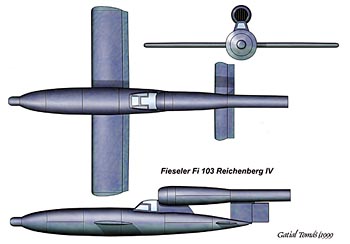 Fieseler Fi 103 Reichenberg
The project was the brain-child of the famous woman pilot Flugkapitan Hanna Reitsch and of the redoubtable adventurer SS-Haupsturmfuhrer Otto Skorzeny. Earlier, Flugkapitan Reitsch had promoted a scheme for the recruitment of a cadre of suicide pilots willing to sacrifice their lives in defense of the Fatherland by crashing their aircraft onto important targets. The scheme met with little favorable response except from a few Nazi fanatics, and was only pursued on a limited scale. ...more
Fi 104 Reichenberg I The Fi 104R-I was the brain child of Hanna Reitsch and SS-Hauptsturmfurhrer Otto Skorzeny. They knew that Germany needed a space fighter if it was to be able to defend its holdings in orbit, and they also knew that it was going to take time to come up with something properly built. As a result, they proposed a stop gap measure of a converted F1 103 with controls for a pilot, life support and a small weapons package which would replace the warhead. The craft was not a success. The cockpit was cramped with very basic controls and life support systems. The engine, while reasonable, was not manoeuvrable and slow to respond, and over all, it is fair to say that the space craft was not liked. ...more
Further Reading
The story of the world's most extraordinary test pilot. Personal test flight stories of such aircraft as the Me163 "Rocket Aircraft" in which Hanna climbs to 30,000 ft. in 90 seconds and it almost cost her, her life. She flys a sailplane into a thundercloud and climb 100 mph to 10,500 feet and has the aircraft and controls lock up from icing. By the grace of God, she survives. Land with Hanna in a sailplane in the middle of a football game in South America. The landing was easy, but the crowd was not.
Hanna Reitsch's father was an opthamologist and wanted her to be a doctor. Her mother taught her a simple faith in God. Above all else, Hanna (1912-1979) wanted to fly. As a result of these influences, young Hanna planned to be a flying missionary doctor. However, over time, the flying influence won out.
By this time she had moved to powered flight and had flown the first practical helicopter, the FW61 - indoors even. Once she demonstrated this revolutionary aircraft for Charles Lindbergh. The Luftwaffe gave her the Military Flying Medal for this and accomplishments with other aircraft. She was the first woman to receive it. ...more
Extensive Image Gallery
|
© Copyright 1999-2002 CTIE - All Rights Reserved - Caution |
